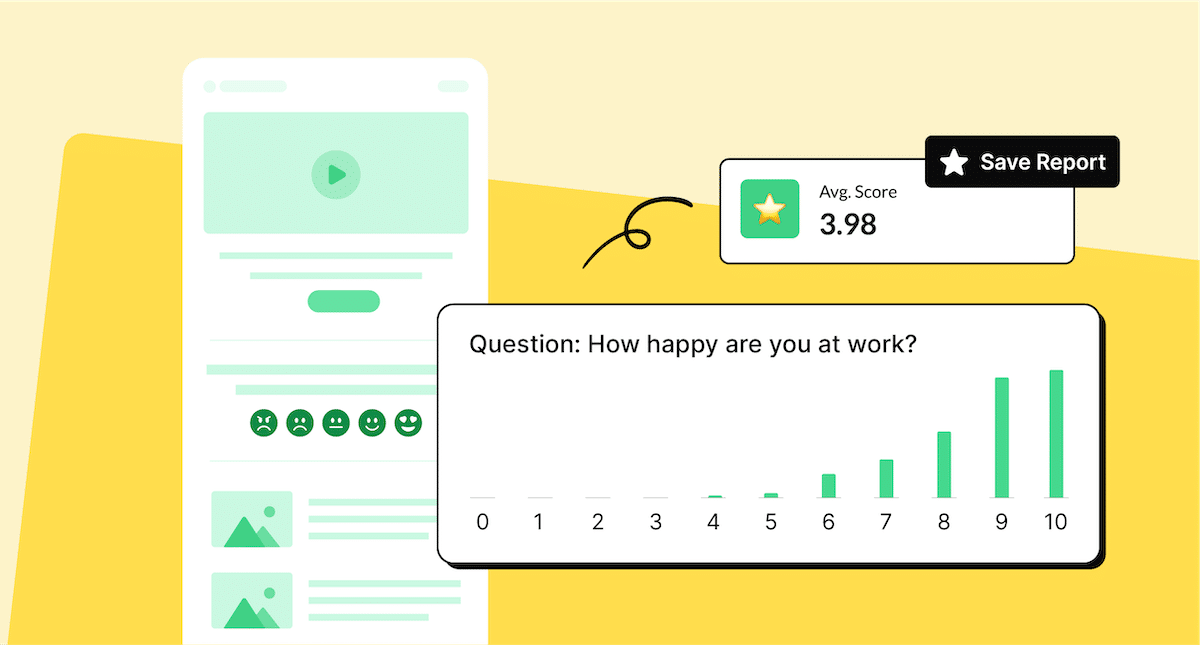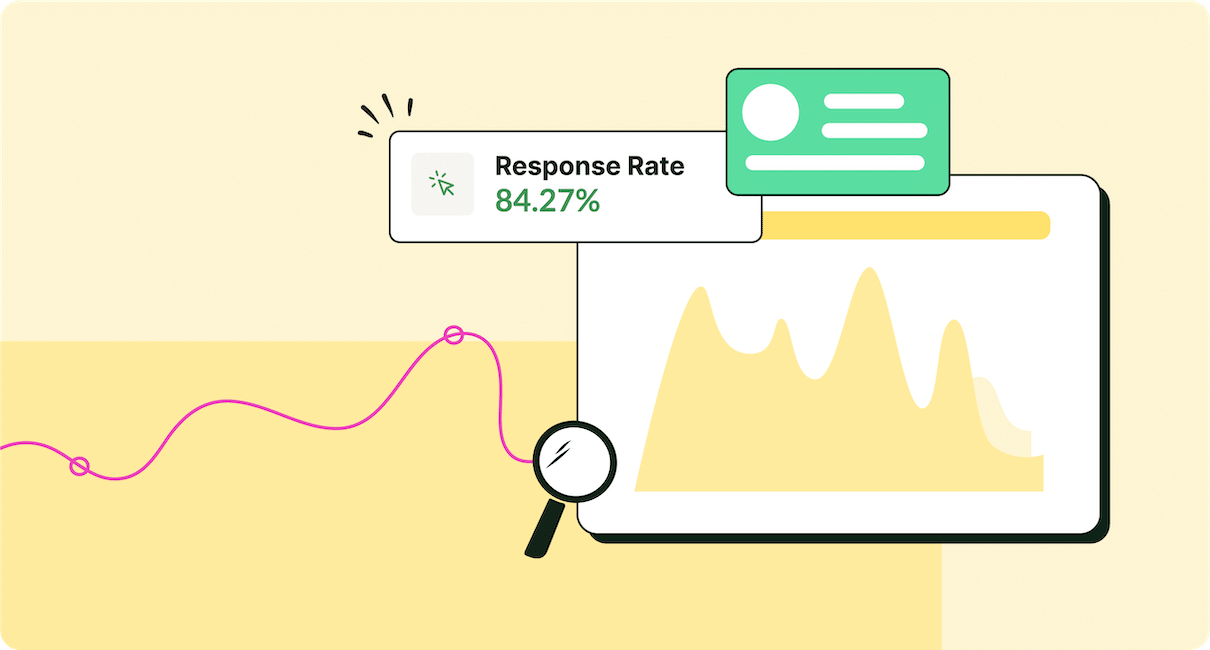An engaged workforce doesn’t happen overnight. Employee engagement surveys help employers understand what drives and hinders their workers, enabling leaders to make changes that drive a lasting culture of true engagement.
Engaged employees are the driving force behind any successful organization. However, fostering engagement in an organization requires effort. In fact, according to the 2025 Global State of Internal Communications Report, 73% of internal communicators rate employee engagement at their organizations as moderate to very low. Yikes!
To create genuine engagement, employees must trust their organizations and feel like their voices matter. That’s why employers looking to increase employee engagement must solicit feedback and work to address employees’ needs and concerns. The best way to do this at scale is by creating an employee engagement survey.
In this blog, we’ll discuss the importance of employee engagement surveys in understanding engagement levels. We’ll also provide practical tips on how to create an employee engagement survey and strategies for analyzing the results to drive meaningful improvements.
Ready to harness the power of employee feedback to create a more engaged and motivated workforce? Read on!
Take a self-guided tour of ContactMonkey
See how our key features can streamline your internal communications.
Take product tour

What Is an Employee Engagement Survey?
An employee engagement survey is a tool used by organizations to determine how engaged employees are with their work and the company as a whole.
So, what do engaged employees look like? For one, they feel a sense of ownership over their work and the company’s direction. Engaged employees are more likely to invest in the company’s future, volunteer for
What is the purpose of conducting an employee engagement survey?
Employee engagement surveys not only seek to understand how engaged a company’s employees are but to also get actionable information on key ways to measurably improve. By collecting feedback with surveys directly from employees, organizations can identify specific areas that need attention and develop strategies to address them.
Often, these surveys also aim to put a numerical value on engagement, such as with such as with the Employee Net Promoter Score (eNPS). An eNPS survey asks a single question, “how likely are you to recommend our company to friends as a place to work?” It then categorizes respondents into promoters, detractors, or passives, and calculates a score representing the ratio of promoters to detractors within your organization.
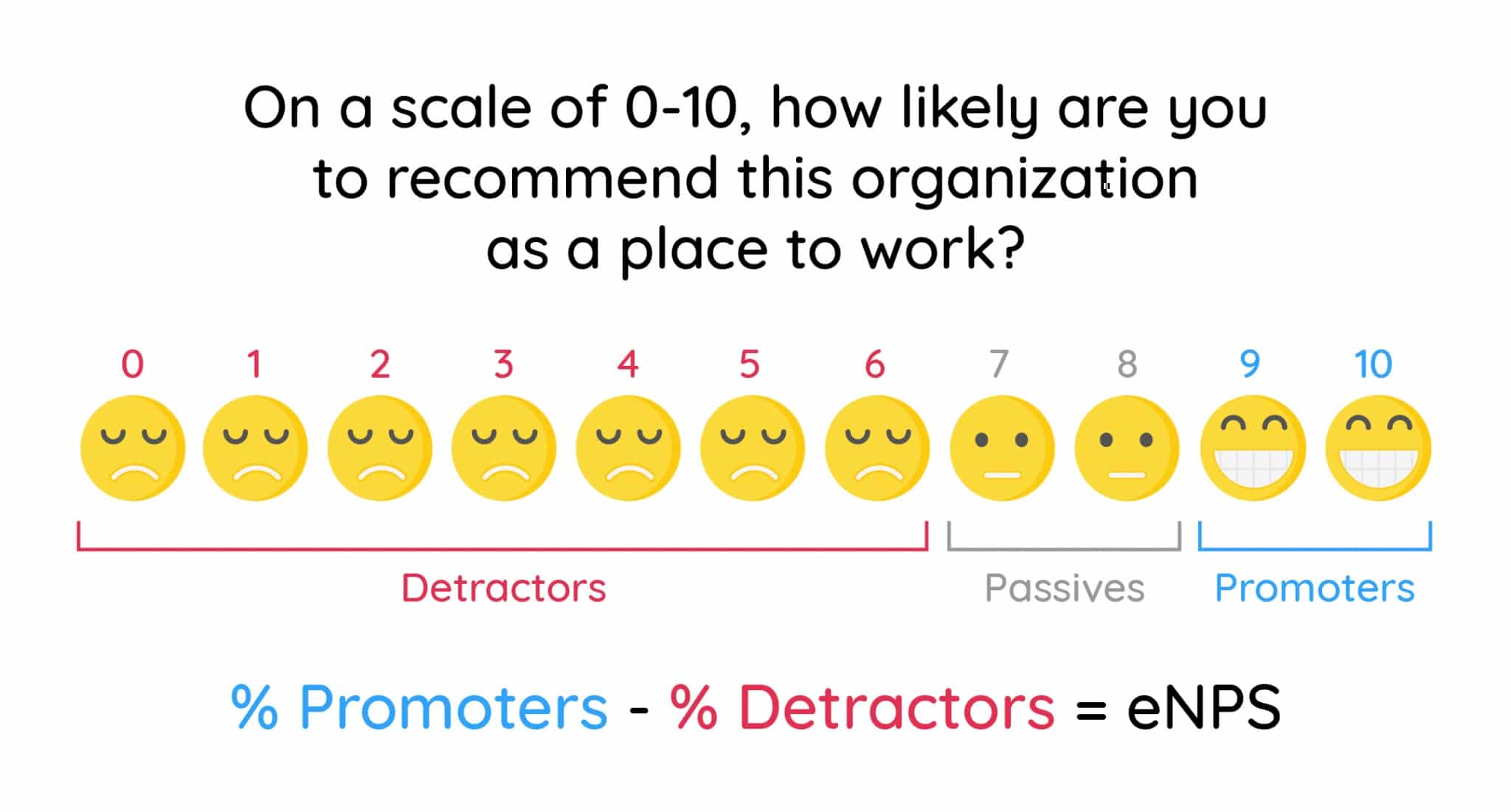
Because eNPS surveys generate a single number representing engagement at your organization, it’s very easy to compare results over time. In the same way, longer-form surveys can collect quantitative and qualitative data to track how engagement changes over time.
Reasons To Conduct Employee Engagement Surveys
What are the benefits of conducting employee engagement surveys? Collecting survey data helps you:
- Understand how engaged your employees really are: Regularly assessing employee engagement maintains an ongoing awareness of your workforce’s morale and motivation levels.
- Identify pain points sooner, not later: Employee engagement surveys help pinpoint issues that affect employee satisfaction and address them before they become full-blown problems.
- Learn what you’re doing right and double down: Without understanding what employees value, you risk undermining the things that made your employees feel engaged in the first place.
- Create actionable benchmarks for employee engagement: Collecting and analyzing survey data helps organizations establish reference points against which to measure progress and the success of their engagement initiatives.
- Plan your internal comms strategically: Understanding what your employees value and what motivates them is the first step to crafting targeted communications and initiatives to drive engagement and align employees with organizational goals.
- Prevent employee turnover: Engaged employees are much less likely to seek opportunities outside of their current employer.
Create and send employee surveys for feedback
Engage staff with pulse surveys, eNPS surveys, reusable surveys, custom polls, and more. Ready to send modern emails?
Explore survey features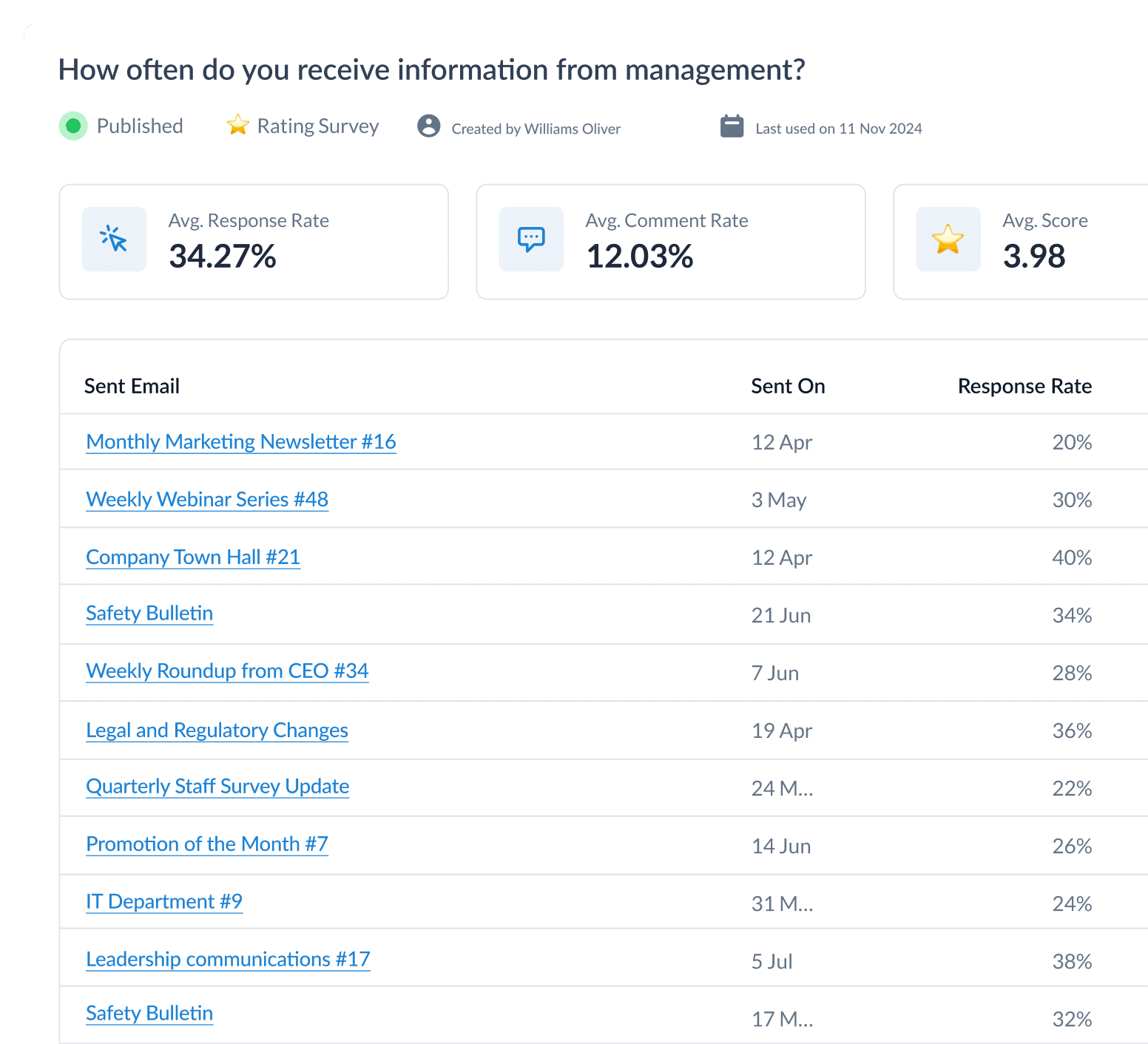
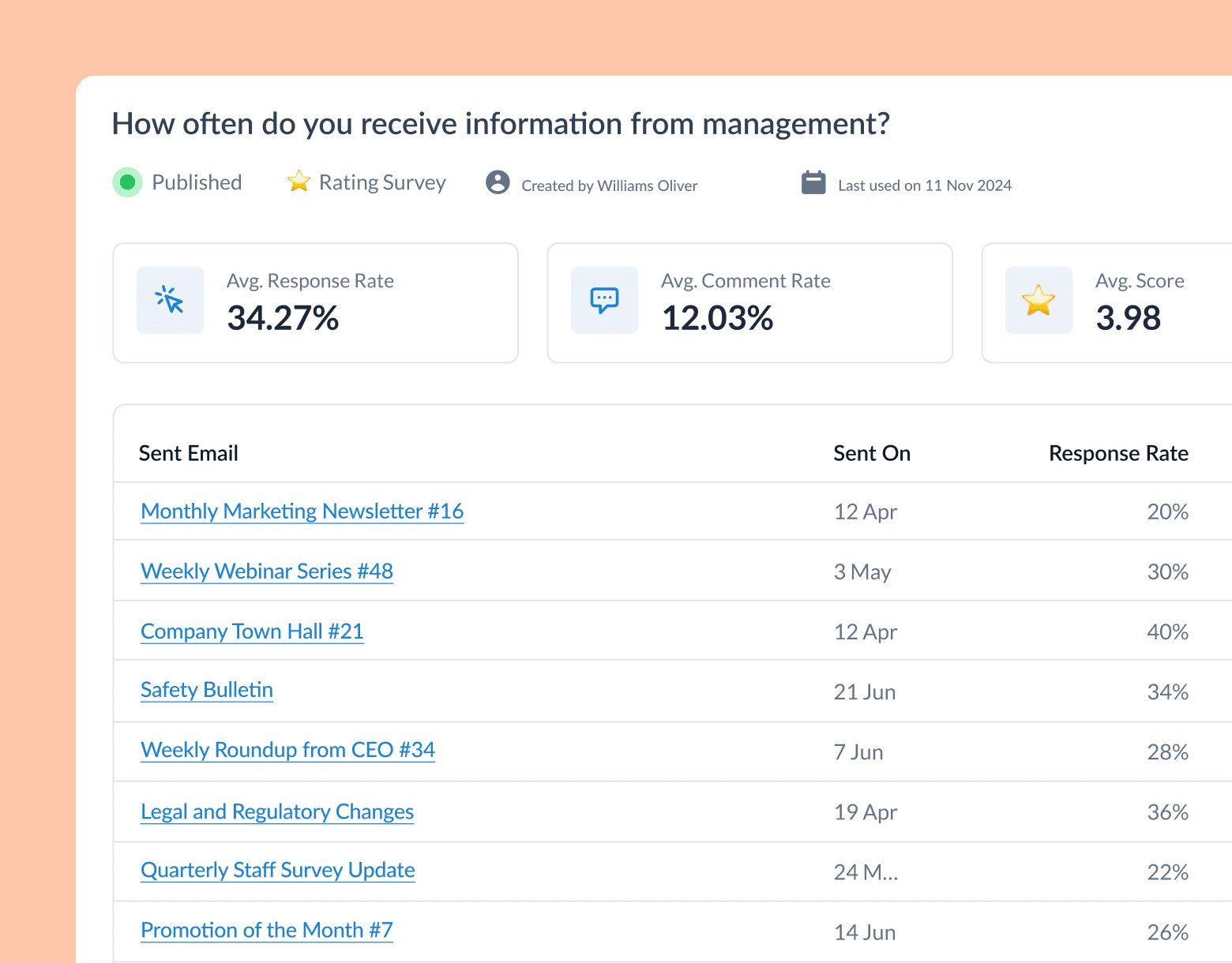
Steps for Designing an Employee Engagement Survey
Unsure how to conduct an employee engagement survey? We’ve laid out our best practices for designing, building, and sending an engagement survey that will collect actionable feedback.
1. Set clear objectives for your survey
Employee engagement is a broad topic encompassing many potential areas of inquiry and methodologies, so before you do anything else, clarify your goals and the reasons for conducting this employee engagement survey.
Consider: Are you seeking feedback on a recent organizational change? Looking for a quick pulse check? Are you focusing on a specific team or department, or do you need a comprehensive view of overall engagement? How often should you conduct employee engagement surveys?
Your specific objectives will shape your survey’s structure and content. Make sure you know exactly what those are before you start building your employee engagement survey.
2. Write your survey questions
Once you know what you want to learn, it’s time to brainstorm employee survey questions. Again, your goal is going to inform what you ask and how many questions you ask, but there is an upper limit to how many questions employees will feasibly get through, so make sure you’re keeping an eye on the length of your survey.
For long-form surveys, consider organizing questions into sections or themes to break up the flow and make the survey less daunting.
Keep your end in mind as you write. Remember, you want actionable data at the end of this exercise, so make sure your questions are directly related to your goals.
Use a mix of multiple-choice and open-ended employee survey questions to gather both quantitative and qualitative data. Include “other” options with space for explanations if applicable. That way, you’re not leaving interesting insights on the table and creating space for employees to bring your attention to any gaps in your survey.
After drafting, step away and revisit your questions after a bit of time to catch any potentially confusing questions or ambiguous wordings. Getting feedback from others who haven’t been involved in the drafting process can also be invaluable on this point.
3. Choose a tool and channel for your survey
How to create an employee engagement survey and what tools you should use will depend on your survey’s parameters and the questions you want to ask. Different tools offer different functionalities, user experiences, and data-tracking capabilities, so choose carefully!
An external tool could be suitable, especially for a longer survey, but external tools can also have specific barriers like requiring employees to navigate to an external site, create an account, or even download a specific app. Generally, putting any additional levels of difficulty between a survey and its audience is a death knell for your participation numbers.
For shorter pulse surveys, your best bet lies with tools that integrate into your existing communication channels, such as ContactMonkey.
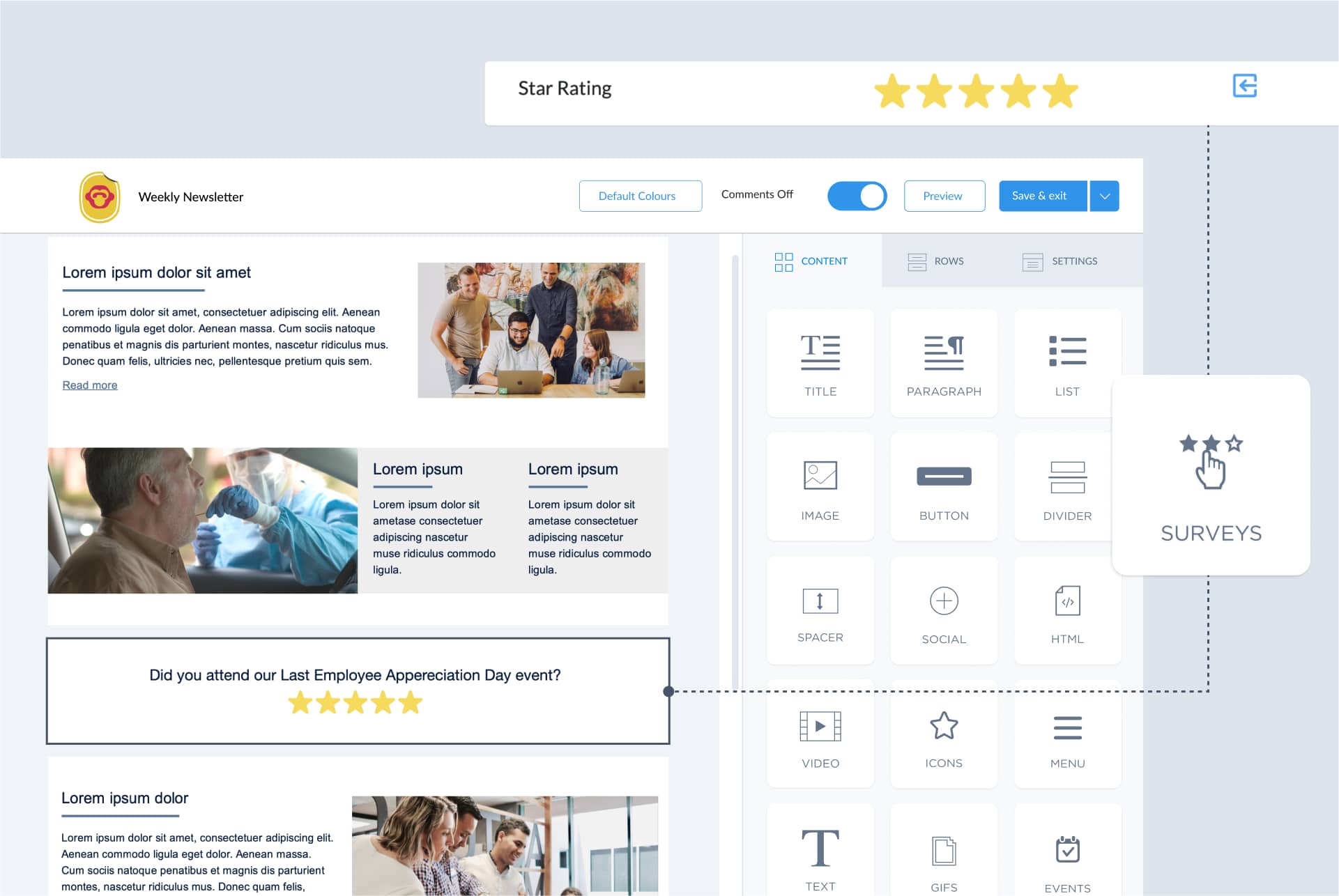
ContactMonkey allows you to embed pulse surveys directly into the internal employee emails you’re already sending. You can build newsletters in the simple drag-and-drop email builder and drop a survey block anywhere you like, then choose from multiple survey types, such as yes/no to star ratings. Emoji reactions, eNPS surveys, and more. You can also allow employees to leave anonymous comments along with their pulse survey responses to encourage candor.
Plus, you can track the results of your surveys directly in your campaign dashboard. ContactMonkey will even calculate your eNPS scores for you.
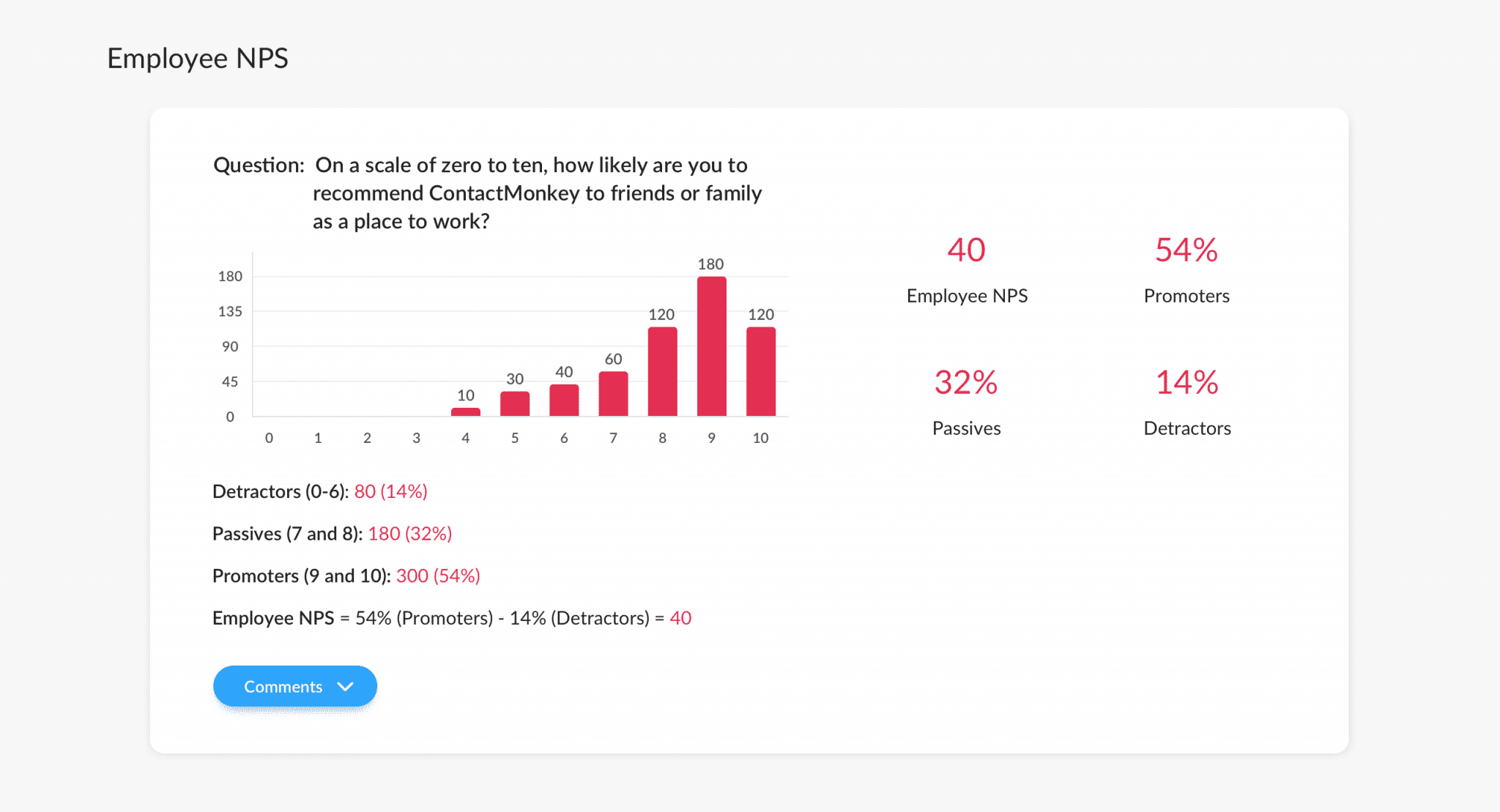
Curious how ContactMonkey can integrate into your employee engagement strategy? Watch a quick demo to learn more!
4. Design and build your survey
When creating an employee engagement survey, pay special attention to user experience and design. Your employee engagement survey design should be super easy to read and navigate, avoiding overwhelming layouts or weird, illegible fonts.
If your survey has several sections, consider separating them into multiple pages. That way, your employees don’t run screaming from one impossibly long page.
You should also consider how your employees will be filling out the survey. If the format isn’t device-specific, make sure you design your survey to be accessible on both mobile and desktop devices.
Also, if you embed a pulse survey in an employee newsletter, make it prominent enough to catch employees’ attention!
Watch ContactMonkey LIVE in action
Join live demo

5. Send and promote your survey
Before distributing your survey widely, conduct a test with a small team to ensure everything looks good. Only once you’ve tested it should you send it out via your chosen channels. We recommend scheduling your survey for a time that will get the maximum number of eyes on it.
Remember, the best sending times will vary by industry. For instance, according to the 2025 Internal Email Benchmark report, the best email sending times for the automotive industry are Wednesday at 8 AM or between 12-1 PM. Find your own best sending times or use industry benchmarks to ensure the most possible eyes on your survey.
Set a clear deadline and send reminders over multiple channels, especially as the deadline approaches. Trust us, even with good intentions, some employees are going to forget the survey without a reminder (or three).
How To Analyze and Measure Employee Engagement Survey Results
The purpose of conducting employee engagement surveys is ultimately to collect and analyze the employee engagement survey results to figure out how to improve your organization. If you’ve sent out your employee engagement survey and are watching responses roll in, you might be at the “now what?” stage.
Here are some of our tips for making the most of your employee engagement survey data:
- Identify the specific aim of your analysis so you know which employee engagement metrics to focus on, whether that’s overall engagement levels, specific engagement drivers, or the areas that need improvement.
- Compare answers to previous employee engagement surveys to understand the fuller context of your results.
- If you don’t have previous survey data, find industry benchmarks to compare your results against.
- For open-ended questions, read through and identify themes or categories of answers. Categorizing responses into these buckets will allow you to analyze them quantitatively.
- Using AI tools or even text search can speed up this process!
- Make note of any outliers in the survey responses, whether positive or negative.
When you’ve done your analysis and put together a summary of the results, make sure to share that information not only with leadership but also with employees. This will demonstrate a commitment to transparency and provide an opportunity to share your action plan for addressing employee concerns.
Need a more in-depth guide to interpreting the results of your employee engagement survey? Check out our blog post on how to analyze employee survey results!


Frequently Asked Questions About Creating Employee Engagement Surveys
Q: Are employee engagement surveys effective?
Employee engagement surveys do well in providing data on how your employees feel about their roles, responsibilities, and the organization itself. They can identify gaps in the organization and help suggest ways to improve.
However, even the most well-written survey won’t make employees more engaged on its own. This is why creating an employee engagement survey is the important first step in a larger engagement strategy. What you do with the data will ultimately determine the effectiveness of the survey in the end.
Q: How often should you conduct employee engagement surveys?
Ideally, you should be sending long-form employee engagement surveys once or twice a year. A thorough employee engagement survey takes time to create, distribute, and answer, so avoid overwhelming your employees with frequent feedback requests. Plus, answers might not vary much if surveys are too close together.
However, if your company has gone through major changes or if you have undertaken a major initiative to boost employee engagement, it might be worth it to send a survey sooner to get a sense of how employees are responding to the changes. Hot tip: make sure that you wait long enough for employees to have meaningful feedback to share!
Q: Can I get the same data and results with employee pulse surveys?
Long-form engagement surveys provide in-depth data, but they’re not the only tool that’s good for gauging engagement. Pulse surveys are quick to create and easy to answer. As such, they’re ideal for filling gaps between major surveys, addressing specific, time-sensitive questions, and continuously monitoring engagement!
While pulse surveys are not a replacement for comprehensive long-form surveys, they’re a great way to supplement your data and monitor changes that occur between longer surveys. And because they can be sent more frequently, they help you stay agile and respond to new conditions within the organization as they occur.
Want to start gathering pulse survey data to monitor employee engagement?ContactMonkey’s internal communication tool lets you easily insert quick pulse surveys into emails and newsletters and monitor results in real time on your campaign analytics dashboard. Book a demo to see how ContactMonkey can help you start gathering employee engagement data in minutes, not days.
Learn How To Motivate Your Employees With a Strategic Employee Engagement Survey
Employee engagement surveys are an essential tool for understanding what makes your workforce tick. By systematically gathering feedback, you can uncover the factors that both inspire and demotivate your employees.
Strong employee engagement doesn’t just happen! It requires a deliberate and thoughtful approach from leaders and communicators within an organization.
By implementing the strategies in this blog, you can design and execute successful employee engagement surveys that guide you in making targeted, company-wide improvements.
Ready to take your employee engagement to the next level? Consider using ContactMonkey to conduct regular employee engagement pulse surveys and track the effectiveness of your engagement initiatives! Book a demo today to see the tool in action.

